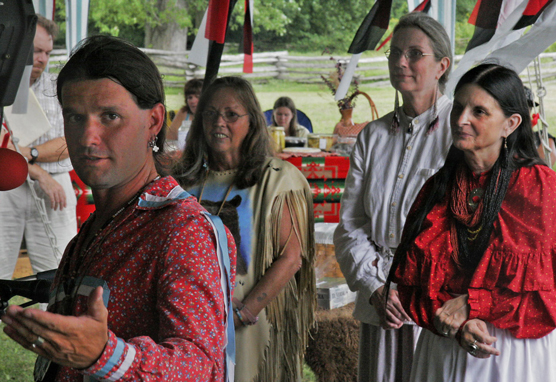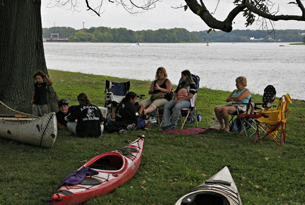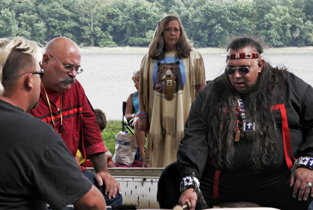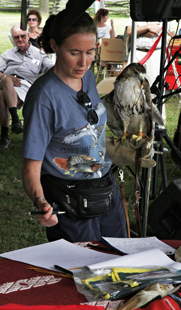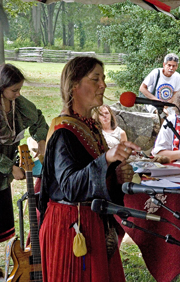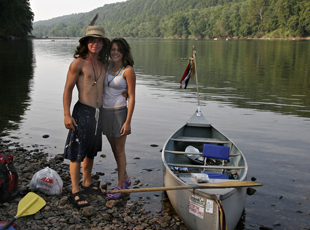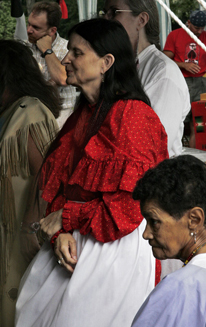by Anne Blackford
The signing ceremony was an afternoon-long affair with food, chanting and music to accompany sigining the Treaty of Renewed Brotherhood. The event attracted hundreds of participants and dozens of treaty signers. Tribal representatives described the signing as “a celebration and commitment to the original shared vision of peace and equality between the Lenape people and William Penn.” It’s part of Lenape efforts to partner with local groups who'll work with them on historical, cultural and environmental awareness.
The event attracted hundreds of participants and dozens of treaty signers, who agreed to help preserve the environment and the river for the next four years. Each treaty signer offered a brief explanation of the commitment. During breaks, there was chanting, drumming, and dancing, plus plenty of food and drink in a large white tent beside the Delaware River.
The treaty aims to keep the river pristine from the point at Hancock, N.Y., where the east and west branches of the Delaware River join, down to Cape May, N.J., where it meets the ocean.
Leading up to the signing, the Rising Nation River Journey began August 4th, as canoers set off from Hancock on their way south. The first journey took place in 2002, and the goal is to repeat the journey and renew the treaty every four years, said spokesman Jim Beer.
The core group traveled approximately 220 miles for ten days, before pulling up at the riverfront grounds of William Penn’s estate. Friends, as well as conservancy and environmental groups, provided meals and campgrounds, and some joined the journey part of the way. Those who traveled with the Lenape shared the goals of protecting the environment and the river.
Shelley DePaul, secretary to the Lenni Lenape Nation, described seeing dazzling wildlife as they moved south: “Golden and American Eagles in the northern river land and cormorants, Great Grey Herons, kingfishers and hawks.” They paddled through the Delaware Water Gap, a place sacred to the Lenape Nation, all the while following the tribe’s motto, “Leave No Trace.”
Richard McNutt, a Lenape member and an industrial engineer from Pipersville, said he’d first visited the spot where the signing took place some forty years ago. At that time, the river banks were so polluted “you couldn’t have eaten for the smell, he said.” Now, with the help of environmental and conservancy groups, the upper parts of the Delaware are relatively clean. The lower tidal section from Pennsbury Manor to the Delaware Bay still needs much work, said McNutt, but the clean-up has succeeded to that point.
The philosophy of the Lenape (pronounced Le-NAH-pe) is peaceful. The notion of ownership of the land, trees, rivers, and animals was alien to them, because they saw all that as part of creation. The Lenape plan to be caretakers of the river for seven future generations, according to Beer, who lives with his family in Sellersville. Before the white settlers came, the Lenni Lenape were seen by other tribes as a “grandfather tribe,” one which acted a reconciler among warring tribes.
The original treaty with William Penn was advantageous to both the Lenape and the settlers, said Beer. With plenty of land, resources could be shared. With no notion of ownership or property, the Lenape saw the Delaware River as a means of bringing people together, rather than the European tradition of seeing rivers as boundary lines.
Kim and Harriet Walker, a mother and daughter from Morrisville, feel “alive and conected during the celebrations at Pennsbury every four years. The elder Mrs. Walker still remembers her youth, when acknowledging her Lenape identity would cause trouble for her family. Like many other descendants, her “secret” lay unspoken and hidden.
What the Lenape describe as the infamous Walking Purchase Hoax was imposed by Penn’s sons in 1732, when three expert runners brought the end of harmonious coexistence by gaining much Lenape land.
The settlers with their weapons, plus diseases like smallpox, nearly eradicated the tribe. Survivors kept being forced north and then west to Ohio and Indiana. Most of the descendants now live on reservations in Kansas and Oklahoma. The ones who remained behind intermarried with the settlers and kept secret their Lenni Lenape heritage.
Now, Jim Beer and other young descendants see the present as a time to expose and celebrate the Rising Lenape Nation. And on August 19th at Pennsbury Manor, they did, with support from many groups who signed the treaty, including the Bucks County Herald
A generous donation of 110 acres of land along the river near Hawley, Pa. by Jane Quick was honored: Chief Chuck Gentleman passed the traditional wampum to Sue Currier, president of the Delaware Highlands Conservancy, which facilitated the gift. The Lenni Lenape will serve as caretakers of the land.
As Virginia Kennedy of Dingman’s Ferry explained, “The River Journey and the Lenape Nation’s long-term goals for the property are opportunities for reconciliation in a world increasingly devoid of the chances for such. The river has two banks, but it is not the banks that count. What matters is our willingness to get in the water and take a better look at the other side.”
------------------
Personal Note
I’d been hearing about the Lenape tribe during my hikes all over the Delaware River basin, and after I made contact at the signing ceremony, I recalled my father telling me that as a boy, he’d unveiled a statue of Pocahontas in Jamestown, Virginia, in 1922--as her youngest direct descendant at the time.
Pocahontas was the Indian princess who married Englishman John Rolfe.
I began wondering what tribe she’d been from, and found that her father, Powhatan, was one of the most powerful chiefs of his day, ruling most of eastern Virginia. Soon, the settlers attacked Powhatan’s tribe, driving them north, where they merged with the Lenape, who pretty much spoke the same language, a version of Algonquian.
So, I guess that makes me part Lenape, too. John Blackford


